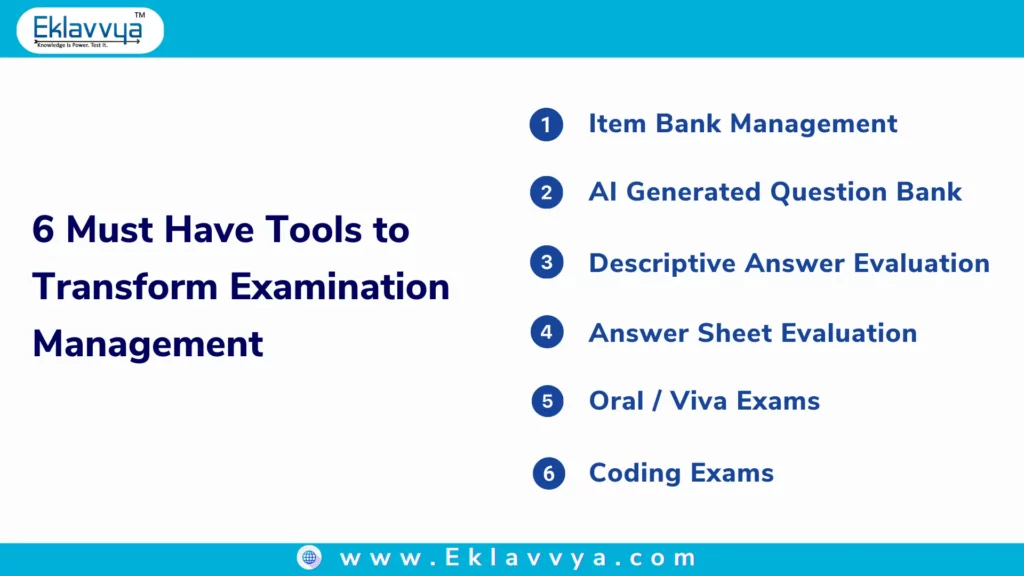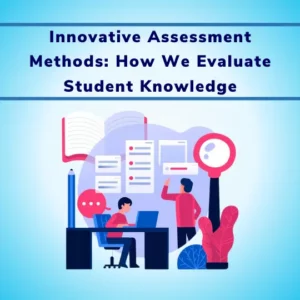Article Contents
Introduction
Examination management is a crucial aspect of academics as it directly impacts the reputation of an educational institution. A well-conducted examination process not only assesses students‘ knowledge but also enhances the institution’s brand in the minds of students.
However, any errors or mistakes during the examination process such as leakage of question papers or incorrect evaluation can harm the institution’s brand.
To improve the examination management process, there are several tools and technologies available. These tools can assist in streamlining the process, reducing errors, and improving overall efficiency. In this article, we will discuss various steps involved in end-to-end examination management and explore how these tools can be effectively utilized to improve the process.
Additionally, we will also delve into the latest AI tools that are emerging in the market and how they can be utilized to enhance examination management.
Here are the 6 must-have online tools for Examination Management-
1. Item Bank Management
Examination management is a crucial aspect of academics, and the first step in this process is to question bank management or item bank management.
This step is key in defining the examination question paper as it involves various entities or subject matter experts who provide their inputs for creating different types of questions. These questions can range from multiple choice questions, descriptive questions, coding-related questions, and questions related to concepts or definitions.
Tools like item bank management or question bank management provided by Eklavvya.com can be used to manage this process.
These tools allow for the definition of roles and responsibilities, where each subject matter expert can log in to the system and define the question bank based on the CO-PO mapping. This question bank acts as an input to the exam question paper creation process.
Once the item bank management or question bank management is done, the next step is defining the question paper. This should be done in a confidential manner to ensure that the question paper does not get leaked to the outside world.
Education institutions and universities typically follow the approach of defining multiple question papers, and at the last minute, one of those papers is selected randomly for the actual examination process.
Exams can happen in an online or offline manner, and in both cases, the examination question paper generation solution provided by Eklavvya.com can be used. This tool provides a streamlined approach for examination management and exam question paper generation. The question papers can be downloaded in multiple formats and can be password protected.
This is useful for managing security associated with question paper distribution, especially in the case of offline exams at multiple exam centers. For online exams, the question papers can be defined based on the examination schema or syllabus associated with it. The system will generate the question paper based on the hierarchy and various aspects of subject topic management.
1. Item Bank Management
Examination management is a crucial aspect of academics, and the first step in this process is to question bank management or item bank management.
This step is key in defining the examination question paper as it involves various entities or subject matter experts who provide their inputs for creating different types of questions. These questions can range from multiple choice questions, descriptive questions, coding-related questions, and questions related to concepts or definitions.
Tools like item bank management or question bank management provided by Eklavvya.com can be used to manage this process.
These tools allow for the definition of roles and responsibilities, where each subject matter expert can log in to the system and define the question bank based on the CO-PO mapping. This question bank acts as an input to the exam question paper creation process.
Once the item bank management or question bank management is done, the next step is defining the question paper. This should be done in a confidential manner to ensure that the question paper does not get leaked to the outside world.
Education institutions and universities typically follow the approach of defining multiple question papers, and at the last minute, one of those papers is selected randomly for the actual examination process.
Exams can happen in an online or offline manner, and in both cases, the examination question paper generation solution provided by Eklavvya.com can be used. This tool provides a streamlined approach for examination management and exam question paper generation. The question papers can be downloaded in multiple formats and can be password protected.
This is useful for managing security associated with question paper distribution, especially in the case of offline exams at multiple exam centers. For online exams, the question papers can be defined based on the examination schema or syllabus associated with it. The system will generate the question paper based on the hierarchy and various aspects of subject topic management.
2. AI-Generated Question Bank
In addition to traditional methods of examination management, there is also an AI tool available that can help you automatically generate a question paper or question bank.
This tool allows you to input information such as the subject topic and the specific skills you want to test in the exam. For example, if you want to conduct an exam on management and want to test the accounting skills of the students at a medium to high difficulty level, with a question mark of three to four marks, the system can generate the question bank for you.
This AI-generated question bank can also be useful in accelerating the question bank management and exam question creation process.
The tool can save you time and effort in creating questions and can also provide a more diverse set of questions, which can provide a more comprehensive assessment of the students.
The AI-generated questions can be more objective and less prone to bias, which can contribute to the validity of the exam.
3. Auto Descriptive Answer Evaluation
The process of evaluating descriptive answers can be a tedious and time-consuming task for educational institutions and universities. Traditionally, examiners have to manually read and assign marks based on the quality of the answers. But what if there is a way to speed up this process and improve its accuracy at the same time?
Visit Eklavvya, a platform that uses AI and machine learning algorithms to automatically evaluate descriptive answers. By taking into consideration a model answer and previously evaluated answers, the system can quickly and accurately assign marks to each answer.
Imagine having to evaluate 10,000 descriptive answers using the traditional manual method. It would take months to complete this task. But with Eklavvya, the same task can be done in just a matter of hours. Not only that, but the system also eliminates the risk of bias that can sometimes occur with manual evaluation.
Overall, implementing an auto-descriptive answer evaluation system like Eklavvya can greatly improve the examination management cycle for educational institutions. It can save valuable time, improve accuracy and eliminate bias from the process. If you’re looking to streamline your evaluation process, Eklavvya is definitely worth considering.
4. Online Answer Sheet Evaluation
Physical answer sheet evaluation can also be a time-consuming and labor-intensive task for educational institutions and universities. Typically, examiners have to visit specific locations, handle physical copies of the answer sheets, and manually evaluate and assign marks. However, with the advent of on-screen evaluation systems, this process can be greatly streamlined and automated.
On-screen evaluation systems work by scanning physical copies of answer sheets and making them available online for examiners to access and evaluate. This system eliminates the need for examiners to travel to specific locations and provides them with the flexibility to evaluate answer sheets from any location. It also saves a lot of costs associated with the calculation of results and improves the accuracy of the overall evaluation process.
One of the major benefits of the on-screen evaluation system is that it can remove the constraints of location, in the traditional method of evaluation, examiners need to be physically present in the examination center or location, which can be difficult if the center is located in a different city, state or country. But with on-screen evaluation, examiners can evaluate the answers sheets sitting at any location, which can save a lot of time, cost, and resources.
On-screen evaluation systems provide a cost-effective, accurate, and efficient method for evaluating physical answer sheets. The system provides a lot of flexibility and can remove the constraints of location. It can also save a lot of costs associated with the calculation of results and can improve the accuracy associated with the overall uncertainty evaluation process. So, it is definitely worth exploring the option of on-screen evaluation systems for educational institutions and universities.
5. Oral / Viva Exams Tool
Oral or Viva exams can be a challenging task for educational institutions and universities to conduct, especially when it comes to scaling and evaluating the exams of thousands of students simultaneously. The traditional way of conducting oral or viva exams is by having an examiner ask questions to the student and the student responds to the answers in person. However, using an online platform like Eklavvya can greatly simplify this process.
Eklavvya allows for the assignment of multiple oral or viva exams to students, where the questions are shown on the screen and the student’s responses are recorded. These recordings can then be listened to at a later point by examiners, who can assign marks accordingly. Additionally, the platform also offers a feature where randomly generated questions can be shown to each student, ensuring that each student receives a different set of questions for the oral or viva exam and that the questions align with the examination syllabus.
One of the major benefits of Eklavvya is that it allows for the simultaneous and concurrent oral or viva exams of thousands of students. This is a huge advantage over the traditional method of oral or viva where it is difficult to scale and conduct exams for thousands of students at the same time. And with the added feature of recording each answer response provided by the student, ensures the suitability of the process.
Technology can greatly simplify the process of conducting oral or viva exams. Using an online platform like Eklavvya, educational institutions and universities can easily scale and conduct concurrent oral or viva exams for thousands of students simultaneously, with the added benefit of having a recording of each answer response for audit purposes.
6. Coding Exams System
Coding exams or practicals can be a challenging task for educational institutions and universities to conduct, especially when it comes to evaluating the code written and compiled by students. The traditional scenario involves examiners visiting students’ laptops or PCs to check the code and manually evaluate the output. But with the advent of online coding assessment platforms, this process can be greatly simplified.
One such platform is Eklavvya which allows you to define coding examples for students to complete in any preferred language such as C, C++, Java, PHP, or others. The student’s code is then compiled and the output is compared with predefined test cases. If the test cases are successful, the student is assigned marks based on their performance.
Online coding assessment platforms like Eklavvya allow you to easily scale your coding assessment process with a high level of accuracy. This eliminates the need for examiners to visit students’ laptops or PCs, which can save a lot of time and resources. Additionally, by using test cases to evaluate students’ code, you can ensure that the marks are assigned objectively and without any bias.
In conclusion, using online coding assessment platforms can greatly simplify the process of conducting coding exams or practicals for educational institutions and universities. It allows for easy scaling of the assessment process and high accuracy in evaluating students’ code. This can save a lot of time and resources and ensure that the marks are assigned objectively.

Conclusion
In conclusion, technology can play a significant role in improving examination management for educational institutions. From item bank management, examination question, and paper generation, to automatic answers evaluation, auto descriptive evaluation, on-screen evaluation systems, and online oral and practical examination platforms, there are a variety of tools and solutions available to streamline and simplify the examination process.
These technologies not only help to save costs associated with the overall examination cycle but also improve the accuracy of the process. From automating the evaluation of answers to providing flexibility in conducting oral and practical exams, these technologies can help to make the examination process more efficient and effective. It can provide end-to-end solutions for examination management which can help to improve the overall experience for students and teachers.
Overall, it is worth considering the implementation of these technologies in order to improve examination management and achieve better results for your educational institution.




![How Government-Led Exams at 250+ Locations Are Setting New Standards of Integrity [Case Study]](https://www.eklavvya.com/blog/wp-content/uploads/2024/04/Enhancing-Exam-Integrity-Government-Certification-in-250-Locations-150x150.webp)
![Transforming Central Govt. Exams Evaluation: How Onscreen Marking is Leading the Charge [Case Study]](https://www.eklavvya.com/blog/wp-content/uploads/2024/04/How-Onscreen-Marking-Revolutionized-Central-Govt-Exams-Case-Study-1-150x150.webp)















![How Onscreen Marking Revolutionized Central Govt Exams [Case Study]](https://www.eklavvya.com/blog/wp-content/uploads/2024/04/How-Onscreen-Marking-Revolutionized-Central-Govt-Exams-Case-Study-1-300x300.webp)
